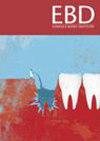Similar patient-reported satisfaction and professional appraisal of implant-supported fixed dental prosthesis fabricated by different workflows
IF 2.3
Q3 Dentistry
引用次数: 0
Abstract
A triple-armed, double-blind randomized controlled trial with cross-over design investigated patient-reported satisfaction and objective dental evaluation of a 3-unit, monolithic zirconium dioxide (ZrO2), implant-supported fixed dental prosthesis (iFDP) fabricated with 2 completely digital workflows and 1 mixed analog-digital workflow. Participants enrolled required rehabilitation of 2 dental implants in posterior region of either of the arches with a 3-unit, ZrO2 iFDP. A total of 20 participants received the 3 types of ZrO2, iFDP fabricated by 3 different methods. Thus, a total of 60 iFDPs were fabricated in the study. 20 iFDP were fabricated by complete digital workflow by using 3Shape Trios 3 Intraoral scanner (IOS) and 3 Shape designing software (Test-1). In second group (Test-2) 20 iFDPs were fabricated by using Dental Wings Virtuo Vivo IOS and Dental Wings original software (DWOS) for CAD designing. 20 iFDPs (control) were fabricated by mixed analogue-digital workflow by using Polyether impression and Exocad Lab software. The primary clinical outcome was blinded, subjective evaluation on visual analogue scale (VAS) by the participant, and an objective evaluation on VAS by a dentist at the time of prosthetic try-in of each of the 3 types of prosthesis. Secondary outcome was patients’ perception about the impression procedures in the 3 different workflows on VAS. The study was conducted at 2 instances during the prosthetic rehabilitation. The primary outcomes were assessed at the time of prosthetic try-in. The secondary outcome was observed after the impression session. Clinical parameters were measured on VAS from 0 to 100 score. For the primary outcome, VAS score was recorded for each iFDP as observed for patient perception (satisfaction) and dentist evaluation (objective). The perception about impression was also recorded on VAS. Descriptive analysis of all scores was done by mean and standard deviation. ANOVA test was used for comparisons among the 3 different types of iFDP. Tukey’s HSD was used for pairwise comparisons within ANOVA. Linear regression analyses was done to compare overall satisfaction of the patients and the dentist within each group. The level of significance was set at α = 0.05. After the start of recruitment in January 2020, there were no losses and exclusions. VAS for patient satisfaction was higher than VAS for dentist evaluation. Patient satisfaction among Test-1, Test-2, and Control showed no significant difference (P = 0.876). Dentist satisfaction among workflows were also not significantly different (P = 0.22). The relationship between VAS scores of patients and dentists was weak for Test-1 (R-value = −0.424, P = 0.062), Test-2 (R-value = 0.116, P = 0.068), and Control (R-value = −0.183, P = 0.441). Significant differences for patients’ perceptions related to the treatment time for impression procedure (P = 0.005), convenience of impression procedure (P < 0.001), bad oral taste with the impression procedure (P < 0.001), and nausea with the impression procedure (P < 0.001) were observed. Subjective patient satisfaction was similar when comparing iFDPs fabricated with 3 different workflows. Objective dentist evaluation was also similar when comparing the 3 types of iFDPs. However, patient satisfaction of the workflow was higher than dentist evaluation, although there was no correlation between the two. Lower VAS in dentist’s evaluation has been attributed to strict standardized clinical criteria and critical expert view. The study also reveals that patients have a favorable perception and preference in favor of digital impressions as compared to use of elastomeric impression materials.不同工作流程制作的种植支撑固定义齿患者满意度及专业评价相似。
设计:一项采用交叉设计的三臂、双盲随机对照试验,研究了采用2个完全数字化工作流程和1个模拟-数字混合工作流程制作的3单元单片二氧化锆(ZrO2)种植支撑固定义齿(iFDP)的患者满意度和客观牙科评价。病例选择:参与者需要使用3单元ZrO2 iFDP在任意一个弓的后区进行2个牙种植体的康复。共有20名参与者接受了3种不同方法制备的3种ZrO2, iFDP。因此,本研究共制备了60个ifdp。采用3Shape Trios 3口内扫描仪(IOS)和3Shape设计软件(Test-1),按照完整的数字化工作流程制作20个iFDP。第二组(Test-2)采用Dental Wings Virtuo Vivo IOS和Dental Wings original software (ddos)进行CAD设计,制作20个ifdp。采用聚醚印痕和Exocad Lab软件,采用模拟-数字混合工作流程制备20个ifdp(对照)。主要临床结果采用盲法,由参与者主观评价视觉模拟量表(VAS),并由牙医在3种假体的每一种试入时对VAS进行客观评价。次要结果是患者对VAS上3种不同工作流程的印象程序的感知。研究时间:研究在假肢康复期间进行了2例。在假体试入时评估主要结果。次要结果在印象期后观察。资料分析:采用VAS评分0 ~ 100分对临床参数进行测量。对于主要结局,记录每个iFDP的VAS评分,观察患者的感知(满意度)和牙医的评价(客观)。在VAS上记录对印象的感知。所有分数的描述性分析采用均值和标准差。采用方差分析(ANOVA)对3种不同类型iFDP进行比较。在方差分析中,使用Tukey’s HSD进行两两比较。采用线性回归分析比较各组患者和牙医的总体满意度。显著性水平设为α = 0.05。结果:2020年1月开始招募后,无遗漏和排除。患者满意度VAS评分高于牙医满意度VAS评分。Test-1、Test-2、Control的患者满意度差异无统计学意义(P = 0.876)。各工作流程的满意度差异无统计学意义(P = 0.22)。测试-1 (r值= -0.424,P = 0.062)、测试-2 (r值= 0.116,P = 0.068)和对照(r值= -0.183,P = 0.441)患者的VAS评分与牙医的相关性较弱。结论:采用3种不同工作流程制作的ifdp患者的主观满意度基本一致。对比3种类型的ifdp,牙医的客观评价也相似。然而,患者对工作流程的满意度高于牙医的评价,尽管两者之间没有相关性。严格的标准化临床标准和专家的批判性意见是导致牙医评价VAS较低的主要原因。研究还表明,与使用弹性体印模材料相比,患者对数字印模有良好的感知和偏好。
本文章由计算机程序翻译,如有差异,请以英文原文为准。
求助全文
约1分钟内获得全文
求助全文
来源期刊

Evidence-based dentistry
Dentistry-Dentistry (all)
CiteScore
2.50
自引率
0.00%
发文量
77
期刊介绍:
Evidence-Based Dentistry delivers the best available evidence on the latest developments in oral health. We evaluate the evidence and provide guidance concerning the value of the author''s conclusions. We keep dentistry up to date with new approaches, exploring a wide range of the latest developments through an accessible expert commentary. Original papers and relevant publications are condensed into digestible summaries, drawing attention to the current methods and findings. We are a central resource for the most cutting edge and relevant issues concerning the evidence-based approach in dentistry today. Evidence-Based Dentistry is published by Springer Nature on behalf of the British Dental Association.
 求助内容:
求助内容: 应助结果提醒方式:
应助结果提醒方式:


